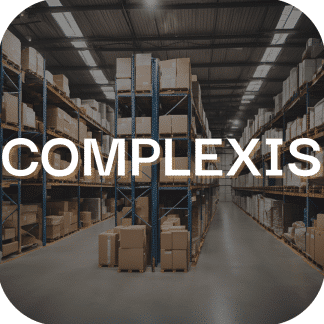Description
Specific Optimization Methods: ABC Analysis and Cost Assessment
Optimization in supply chain management is a complex, multifaceted endeavor that benefits from specific analytical methods. Among the most effective are ABC Analysis for product hierarchy and Cost Analysis for stock level and service rate adjustment. This guide dives into these advanced techniques to help you refine your supply chain strategies.
ABC Analysis: Prioritize Your Inventory
ABC Analysis is a methodology used to classify inventory into three categories, A, B, and C, based on their importance.
- Category A: High-value items with low frequency.
- Category B: Moderate value items with moderate frequency.
- Category C: Low-value items with high frequency.
How it Works
- Sort Inventory: Rank products by annual consumption value.
- Categorize: Assign them to A, B, or C categories.
- Review and Adjust: Periodically revisit the ABC analysis to adjust strategies as market conditions change.
Benefits
- Focused Inventory Control: Prioritize high-impact items.
- Efficient Use of Resources: Allocate resources where they have the most effect.
Cost Analysis: Fine-Tune Stock Levels and Service Rates
Understanding cost behavior is essential for optimizing stock levels and service rates. The focus is on two main components:
- Holding Costs: The cost of storing products, often as a percentage of the product’s value.
- Stockout Costs: Costs incurred when an item is not available, including lost sales and customer dissatisfaction.
Methods
- Compute Costs: Determine the holding and stockout costs.
- Analyze Service Rates: Examine the cost-effectiveness of different service levels.
- Adjust: Modify stock levels and service rates based on the analysis.
Benefits of Implementing ABC Analysis and Cost Analysis in Supply Chain Management
- Reduced Costs: By adjusting stock levels, minimize holding and stockout costs.
- Optimized Service Levels: Achieve the best balance between service quality and cost.
While generic optimization strategies provide a broad framework for supply chain improvement, targeted approaches like ABC Analysis and Cost Analysis offer specific, actionable insights. These methodologies help fine-tune your inventory control, resource allocation, and service levels, leading to a more streamlined and cost-effective supply chain operation.
The implementation of ABC Analysis and Cost Analysis in supply chain management offers a myriad of benefits that extend beyond simple inventory management to broader business impacts such as enhanced financial performance, improved operational efficiencies, and increased customer satisfaction. Here’s a detailed exploration of these benefits:
Enhanced Financial Performance
1. Optimized Inventory Investment:
ABC Analysis allows companies to identify which items contribute the most to their revenue (Category A), which are less critical but still significant (Category B), and which contribute the least (Category C). This understanding enables firms to invest capital more judiciously, allocating more resources to high-value items and reducing excess capital tied up in less critical items. This strategic allocation helps in reducing carrying costs and improving cash flow.
2. Reduced Holding Costs:
By understanding the specific costs associated with holding each category of items, companies can make informed decisions about where to cut costs without impacting product availability. For instance, reducing safety stock levels for Category C items can significantly lower holding costs without substantially increasing the risk of stockouts.
3. Decreased Stockout Costs:
Cost Analysis provides insights into the trade-offs between holding costs and stockout costs. By analyzing these costs in detail, businesses can fine-tune their inventory levels to minimize the occurrence of stockouts, especially for high-priority items, thus avoiding lost sales and the negative impact on customer satisfaction that comes with unavailability of products.
Improved Operational Efficiencies
4. Prioritized Inventory Management:
With ABC Analysis, operational efforts and warehouse space can be prioritized for A-category items, ensuring that the management of these critical items is flawless. This prioritization leads to more efficient use of warehouse space and resources, such as personnel and inventory management systems.
5. Streamlined Procurement and Replenishment:
Effective categorization of inventory facilitates more streamlined procurement processes. For instance, automatic reordering systems can be set up for high-turnover C items, while more careful, manual replenishment processes can be reserved for A items that require greater investment and risk management.
6. Enhanced Demand Forecasting:
By focusing on the items that have the most significant impact on the business, companies can allocate more analytical resources to improve the accuracy of demand forecasts for these items. Accurate forecasting helps in reducing the costs associated with overstocking and understocking.
Increased Customer Satisfaction
7. Improved Service Levels:
By maintaining optimal inventory levels through precise Cost Analysis, companies can ensure that they meet customer demand without delay. This optimization helps in achieving higher service levels, leading to increased customer satisfaction and loyalty.
8. Reduced Lead Times:
Efficient management of the supply chain, particularly for A and B category items, leads to reduced lead times. Faster turnaround times for these critical products not only improve customer satisfaction but also enhance the company’s competitive edge in the market.
9. Adaptive to Market Changes:
Regular review and adjustment of ABC categories allow companies to adapt quickly to market changes. Products can shift between categories as their sales patterns change, ensuring that inventory management strategies remain aligned with current market conditions.
The technical implementation of ABC Analysis and Cost Analysis not only optimizes the operational aspects of inventory management but also drives broader strategic benefits, including financial gains, operational efficiency, and customer satisfaction. These methodologies empower businesses to align their inventory practices with their overall business objectives, leading to a robust, responsive, and efficient supply chain. By fine-tuning their approach based on detailed insights from these analyses, companies can ensure that they maintain a competitive edge in the fast-paced market environment.
Implementation Challenges and Solutions
Despite the clear benefits of ABC Analysis and Cost Analysis, their implementation in supply chain management can present challenges. Identifying potential hurdles and devising strategies to overcome them is critical for achieving success.
1. Data Accuracy and Availability
Challenge: Both methodologies require accurate, up-to-date data on inventory levels, consumption patterns, holding costs, and stockout costs. Poor data quality can lead to incorrect categorization and suboptimal decisions.
Solution: Invest in advanced inventory management systems that provide real-time data and analytics. Regular audits of data accuracy and system calibration are essential to maintain the integrity of the analysis.
2. Resistance to Change
Challenge: Introducing new analytical methods often meets resistance from stakeholders accustomed to traditional processes.
Solution: Conduct training sessions for staff and communicate the benefits of these methods in improving efficiency and reducing costs. Use pilot projects to demonstrate the value of these analyses on a smaller scale before full implementation.
3. Balancing Costs with Service Levels
Challenge: Determining the optimal balance between holding costs and stockout costs can be complex, particularly for items that have unpredictable demand.
Solution: Use advanced predictive analytics and simulation tools to model different scenarios. These tools can help determine the ideal stock levels for each category while maintaining desired service levels.
4. Complexity of Categorization
Challenge: Assigning products to A, B, and C categories or accurately calculating costs can become complicated, especially in industries with vast and diverse inventories.
Solution: Start with a simplified approach and refine it over time. Leverage machine learning algorithms to automate categorization based on multiple parameters, such as demand variability and profit margins.
Future Trends in Inventory Optimization
As supply chain management evolves, new technologies and methodologies are shaping the future of inventory optimization. Here are some key trends that businesses should watch:
1. Integration of Artificial Intelligence (AI)
AI can enhance both ABC Analysis and Cost Analysis by automating categorization, identifying patterns in consumption, and predicting demand with greater accuracy. AI-powered tools can also dynamically adjust stock levels and service rates in response to real-time changes in the supply chain.
2. Advanced Analytics and Big Data
Big data enables more granular insights into inventory management. By analyzing vast amounts of data from multiple sources, companies can refine their categorization and cost assessments, uncovering hidden opportunities to optimize their supply chain.
3. Blockchain for Transparency
Blockchain technology provides a transparent, immutable record of inventory movements and costs. This transparency can improve trust among stakeholders and streamline processes like auditing and compliance.
4. IoT-Driven Smart Warehousing
The Internet of Things (IoT) enables real-time tracking of inventory levels, locations, and conditions. Smart sensors and RFID technology provide actionable data that can feed directly into ABC Analysis and Cost Analysis models for more precise decision-making.
5. Focus on Sustainability
Sustainability is becoming a critical consideration in inventory optimization. Businesses are exploring ways to reduce waste, minimize overstocking, and ensure ethical sourcing, all while maintaining high service levels.
ABC tools and analysis
ABC Analysis and Cost Analysis are powerful tools that enable businesses to achieve significant improvements in their supply chain operations. When implemented correctly, these methodologies not only optimize inventory management but also drive financial performance, enhance operational efficiency, and boost customer satisfaction.
However, successful implementation requires overcoming challenges related to data accuracy, stakeholder buy-in, and complexity. By leveraging emerging technologies like AI, IoT, and blockchain, businesses can further refine these analyses and adapt to the dynamic market environment.
As supply chains become more complex and customer expectations continue to rise, the ability to implement advanced optimization methods will be a key differentiator. Companies that invest in these tools and processes will be better positioned to thrive in an increasingly competitive global market, delivering value to their customers while maintaining operational excellence.




